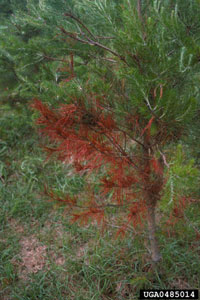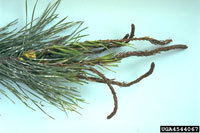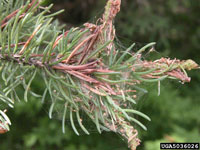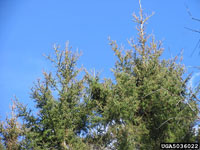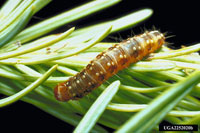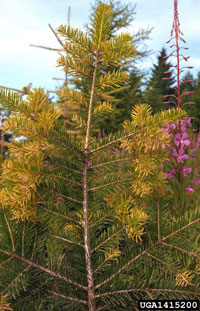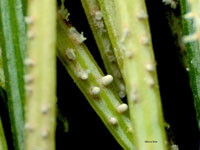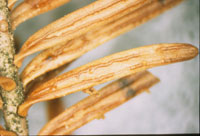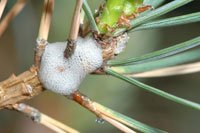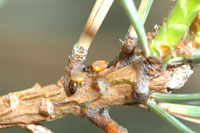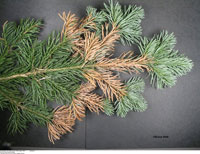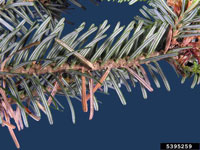Extension > Garden > Diagnose a problem > What's wrong with my plant? > Evergreen Trees and Shrubs > Fir > Yellow to reddish-brown needles
Fir > Needles > Yellow to reddish-brown needles on part to most of tree
1 of 6
Glyphosate herbicide damage
(e.g. Roundup)
- Needles retain shape but turn pale yellow to reddish-brown
- If damage is severe, needles drop and branches may die
- Symptoms occur a few days to several weeks after herbicide application
- Dead or dying weeds expressing similar symptoms may be present nearby
- More information on Glyphosate herbicide damage
2 of 6
Spruce budworm
Choristoneura fumiferana
- Branch tips or branches defoliated
- Needles webbed together in clumps attached to twigs, turning reddish brown by July
- Light to moderate infestations confined to upper crown
- Prefers balsam fir; also feeds on spruce, pine and larch
- Larva has black head, light brown to gray brown with small spots, up to 1 inch long
- More information on Spruce budworm
3 of 6
Fir needle rusts
Fir-fern (Uredinopsis spp., Milesina spp.), Fir-fireweed (Pucciniastrum epilobii), Fir-blueberry (Pucciniastrum goeppertianum)
- Current year needles turn yellow and sometimes curl
- Diseased needles may turn brown and drop prematurely resulting in thin foliage
- White or yellow tube-shaped spore producing structures form on the underside of infected needles
- Difficult to distinguish between these diseases in the field; lab analysis often required
- Rust infection on nearby alternate host, fern, fireweed or blueberry may aid in diagnosis
- More information on Fir needle rusts
4 of 6
Lirula needle blight
Lirula mirabilis and L. nervata
- 1 yr old needles reddish-brown in June and July
- Diseased needles turn gray with age and remain attached for several years
- L. nervata – a raised black line develops along the midrib of infected 3-4 yr old needles
- L. mirabilis - 2 raised lines, the color of the needle, develop parallel to the midrib of 3-4 yr old needles
- Lower branches most affected
- Cool, wet weather favors this disease
- More information on Lirula needle blight
5 of 6
Pine spittlebug
Aphrophora parallela
- White foamy mass on twigs and needles May to early June
- Look within for small (up to ¼ inch), black and pale yellow nymphs
- Heavy infestations can flag and discolor shoots
- More information on Pine spittlebug
6 of 6
Rhizosphaera needle cast
Rhizosphaera pini
- Drooping, grayish-tan needles in late spring or early summer
- Needles at the branch tips remain green, while older needles closer to the trunk of the tree become discolored
- Tiny black dots can be seen with a hand lens on infected needles
- Discolored needles fall off mid-summer; tree looks thin and bare
- Damage typically starts on the lower branches and moves up the tree
- More information on Rhizosphaera needle cast



